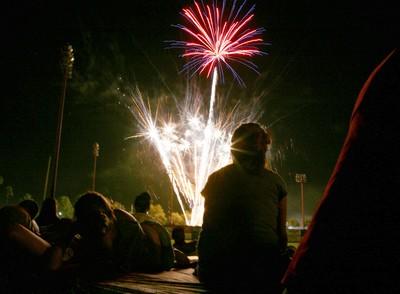It’s Gonna Be a Scorcher

Broiling? Sizzling?
Yes, it’s freakin’ hot out there.
The National Weather Service issued an excessive heat warning Tuesday through Friday predicting near record high temperatures across much of Southern Nevada that are expected to "bring dangerously hot" conditions to the Mojave Desert.
Charlie Schlott, a weather service meteorologist in Las Vegas, said "dangerously hot" means that when temperatures are 112 degrees to 115 degrees as called for in the forecast for today and Thursday "you have a tendency to dehydrate real fast and people outside will have a big problem.
"We put this warning out especially for the elderly and people who are vulnerable to this," he said. "You have to use common sense when out and about in this heat. … You can become dehydrated really quick before you know it. You step outside and, ‘wow.’ "
In the sun, temperatures will be at least 10 degrees higher than the official temperature, which is recorded in the shade at McCarran International Airport.
Schlott stressed that parents should avoid leaving children in vehicles where temperatures can easily reach 140 degrees, a fatal scenario. Likewise, pet owners should bring their animals inside air conditioned homes, he said.
The warning, which took effect at noon Tuesday, advises residents and "especially tourists who are not acclimated to the desert heat" to plan outdoor Fourth of July celebrations for early morning and late evening.
"Remain in air conditioned buildings during the hottest part of the day. … Use extra caution and remember to drink plenty of water," the warning reads.
On Tuesday, the high temperature at McCarran airport reached 111 degrees, eight degrees above normal but five degrees below the 116-degree record for July 3. Today and Thursday, Schlott said, could tie respective records of 115 and 116 degrees for those dates, last reached in 1985.
The all-time high temperature for the Las Vegas Valley since official record keeping began in 1937 is 117 degrees on July 19, 2005, which tied the extreme high temperature record set on July 24, 1942.
According to Tuesday’s warning, extreme heat is expected through Friday due to a strong area of higher pressure over the Las Vegas Valley and surrounding areas.
"High temperatures Tuesday through Friday are expected to be 112 to 116 in Las Vegas … 118 to 121 along the Colorado River valley, including Lake Mead and Lake Mohave (and) 115 to 118 in the Mesquite area," the warning reads.
A high temperature of 123 degrees today or Thursday at Lake Mead National Recreation Area "would not be out of the question," Schlott said.
National Park Service spokeswoman Roxanne Dey said officials in the recreation area are advising visitors to stay hydrated by drinking water with electrolytes added. People who drink alcohol will dehydrate faster, she said.
"We’re telling people to bring shade," Dey said. "If they can, leave little babies at home. They just can’t take the heat."
Last year, some 300,000 visitors came to the recreation area on the Fourth of July.
Visitors flocking to Lake Mead National Recreation Area today may fare only slightly better than those in Death Valley National Park, ground zero for extreme heat in the Western Hemisphere. The desert park about 180 miles west of Las Vegas has endured highs in the low 120s and overnight lows in the mid 90s so far this week.
"The forecast for Thursday is 127. It could easily come in a degree or two either way," said Terry Baldino, spokesman for the national park.
Baldino said 127 degrees might be enough to set a new record for early July, but he doesn’t expect the current heat wave to seriously challenge what he called "the record."
That came July 10, 1913, when the mercury hit 134 degrees near present day Furnace Creek Ranch, now the site of Death Valley’s official weather station. Fahrenheit 134 still stands as the highest temperature ever recorded in the Western Hemisphere.
"It would still be interesting if it hit 130 (this week), because that hasn’t happened for a very long time," Baldino said.
Already this summer, park personnel have responded to a number of heat-related medical calls. "Most of them were treated-and-released-type situations," Baldino said. "We’ve been very lucky so far."
Complicating the extreme, dry heat situation in Southern Nevada — humidity is only 5 percent — is the lack of precipitation this year.
Because of the lack of water, the Bureau of Land management will conduct an emergency gather of 200 wild horses Friday through Sunday in a remote area of Nellis Air Force Range.
"The lack of water and severe temperatures have dried up existing water sources in the Kawich Valley for the wild horses," reads a BLM statement Tuesday that quotes Las Vegas Field Office Manager Juan Palma.
"The horses will suffer from dehydration if we don’t remove them," Palma said.
The weather service hasn’t recorded any precipitation in the Las Vegas Valley since a trace of rain on May 5. Since Jan. 1, there’s only been 0.3 inch of precipitation, which is about 2 inches below normal for the year through Monday.
Review-Journal writer Henry Brean contributed to this report.